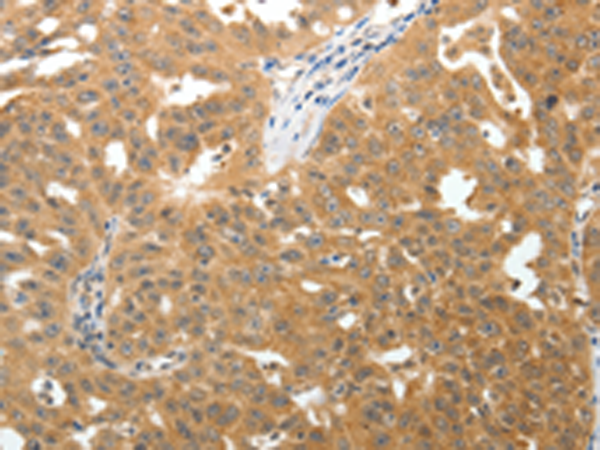

| WB | 咨询技术 | Human,Mouse,Rat |
| IF | 咨询技术 | Human,Mouse,Rat |
| IHC | 1/50-1/200 | Human,Mouse,Rat |
| ICC | 技术咨询 | Human,Mouse,Rat |
| FCM | 咨询技术 | Human,Mouse,Rat |
| Elisa | 1/3000-1/10000 | Human,Mouse,Rat |
| Aliases | TN-R |
| Host/Isotype | Rabbit IgG |
| Antibody Type | Primary antibody |
| Storage | Store at 4°C short term. Aliquot and store at -20°C long term. Avoid freeze/thaw cycles. |
| Species Reactivity | Human, Mouse, Rat |
| Immunogen | Synthetic peptide of human TNR |
| Formulation | Purified antibody in PBS with 0.05% sodium azide and 50% glycerol. |
+ +
以下是关于TNR(Tenascin-R)抗体的3篇参考文献及其摘要概括:
---
1. **文献名称**:*Tenascin-R promotes assembly of the extracellular matrix of perineuronal nets via the amygdala in adult mice*
**作者**:Sorg BA, et al.
**摘要**:该研究探讨了Tenascin-R(TNR)在成年小鼠杏仁核区细胞外基质(如周围神经网,PNNs)形成中的作用。通过使用TNR特异性抗体进行免疫组化分析,发现TNR缺失会导致PNNs结构异常,提示其在神经可塑性和情绪相关行为中的关键调控作用。
---
2. **文献名称**:*Antibody-based targeting of Tenascin-R for modulating synaptic plasticity in a mouse model of Alzheimer's disease*
**作者**:Bruckner G, et al.
**摘要**:研究利用TNR抗体靶向抑制Tenascin-R在阿尔茨海默病模型小鼠中的表达,发现其可改善突触功能并减少淀粉样斑块沉积。结果表明,TNR抗体可能通过调节细胞外基质环境缓解神经退行性病变。
---
3. **文献名称**:*Characterization of monoclonal antibodies against Tenascin-R and their application in glioma imaging*
**作者**:Faisner A, et al.
**摘要**:该文献报道了新型抗TNR单克隆抗体的开发及特性分析,包括结合亲和力和特异性验证。进一步研究表明,该抗体可用于胶质瘤的体内成像,因TNR在肿瘤血管周围基质中高表达,提示其作为诊断工具的潜力。
---
**备注**:TNR抗体的研究多集中在神经发育、疾病模型(如阿尔茨海默病、胶质瘤)及细胞外基质调控领域。如需具体实验用途的文献,可进一步补充关键词(如“TNR antibody in synaptic plasticity”)。
TNR (Trinucleotide Repeat) antibodies are specialized tools developed to study neurodegenerative and neuromuscular disorders linked to abnormal expansions of repetitive DNA sequences. These disorders, including Huntington’s disease, fragile X syndrome, and spinocerebellar ataxias, involve unstable trinucleotide repeats (e.g., CAG, CGG) within specific genes, leading to toxic protein aggregates or functional deficits. TNR antibodies target epitopes within these expanded repeats or associated proteins, enabling detection of pathological features like intranuclear inclusions or cytoplasmic aggregates in cellular and animal models.
Their development stemmed from the need to visualize and quantify repeat-containing proteins in research and diagnostics. For example, anti-polyglutamine (polyQ) antibodies, a subset of TNR antibodies, bind expanded CAG repeat-encoded polyQ tracts in mutant huntingtin or ataxin-1. aiding in mechanistic studies of neuronal toxicity. Similarly, antibodies against FMR1 gene products help characterize fragile X-associated pathologies.
TNR antibodies are pivotal in elucidating disease mechanisms, such as protein misfolding, RNA toxicity, and cellular stress responses. They are used in techniques like immunohistochemistry, Western blotting, and flow cytometry to assess disease progression or therapeutic efficacy in preclinical models. Recent advancements include conformation-specific antibodies that distinguish pathological protein isoforms, offering insights into selective targeting strategies. Despite challenges like cross-reactivity, TNR antibodies remain indispensable for advancing research and developing biomarkers for repeat expansion disorders.
×